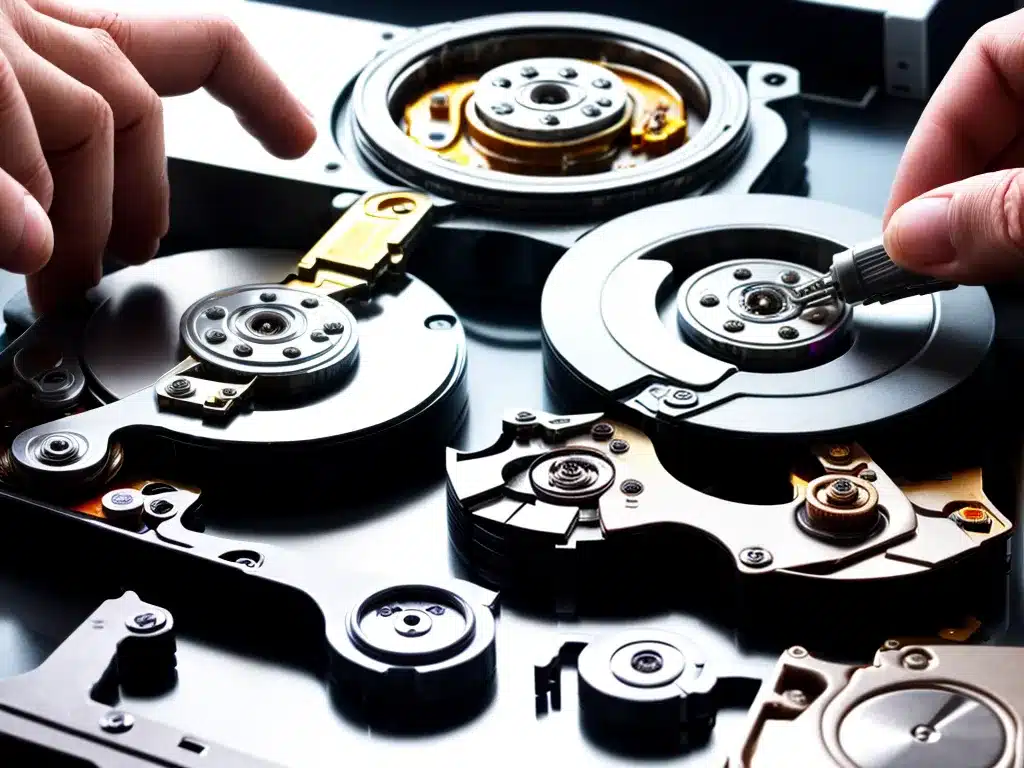
Introduction
Hard drive clicking or ticking noises are never a good sign. These sounds usually indicate that the read/write heads are making contact with the platters inside the hard drive and that mechanical failure is imminent. Data recovery from a clicking hard drive can be challenging, but with the right tools and techniques, it is often possible to recover data even from a drive that is experiencing physical issues. In this article, I’ll provide an in-depth look at clicking hard drive failure, explain what options are available for data recovery in 2024, and outline the steps you can take to give yourself the best chance of getting your files back.
Understanding Clicking Hard Drive Failure
Clicking or ticking noises point to a mechanical problem within the hard drive. Specifically, they indicate an issue with the drive’s read/write heads and/or actuator arm. There are a few common causes:
Stuck or Failing Read/Write Heads
The read/write heads float just above the drive’s spinning platters on a thin cushion of air. If the heads fail or get stuck, they can make contact with the platters. This creates the clicking or ticking noise as the heads rapidly tap against the platters during disk rotation.
Misaligned or Out-of-Balance Actuator Arm
The actuator arm controls the movement of the read/write heads. If this arm becomes misaligned or out-of-balance, it may oscillate or vibrate, causing the heads to intermittently hit the platters.
Degraded or Contaminated Lubricant Layer
Hard drive platters have a microscopically thin lubricant coating. If this layer degrades or becomes contaminated with dust or smoke residue, friction increases between the heads and platters, leading to tapping and clicking sounds.
In all cases, the physical impacts between the heads and platters can damage both components over time. Data loss occurs as a result. Acting quickly at the first signs of a clicking drive gives you the best chance for recovery.
Data Recovery Options for Clicking Hard Drives
When confronted with a clicking hard drive, you essentially have two options if you want to recover your data – try DIY recovery techniques or use a professional data recovery service.
DIY Data Recovery
With some computer skills and the right tools, DIY data recovery is possible:
-
Hard drive dock – A simple external docking station lets you access the drive’s contents like a regular external drive, as long as it spins up and gets detected.
-
Data recovery software – Programs like Ontrack, R-Studio, or Reclaime can recover deleted files and lost partitions.
-
Repair tools – Software like HDD Regenerator tries to repair damaged platters by rewriting data.
-
DIY head transplant – Carefully swapping heads from a matching functional donor drive can get a clicking drive working again.
The main risk with DIY recovery is further damaging the drive and losing data permanently. Success depends heavily on your technical skill.
Professional Data Recovery
For challenging mechanical problems, professional data recovery services offer the best results. A few key advantages:
-
Clean room environment – Technicians disassemble drives and swap components using specialized tools in a dust-free clean room. This avoids contamination.
-
Advanced techniques – Services may use specialized hardware and proprietary recovery methods unavailable to consumers. This improves the odds of recovery.
-
Expertise – Experienced engineers understand these complex issues and have the best chance of salvaging data.
Of course, professional recovery can be expensive, often $400 to $3000 or more. But for critical business or personal data, the cost may be warranted.
Best Practices for Clicking Hard Drive Data Recovery
If faced with a clicking hard drive, follow these best practices to maximize your chances of successful data recovery:
1. Stop Using the Drive Immediately
At the first signs of clicking or ticking, power down the drive and disconnect it to prevent further damage from power cycling or use.
2. Research Your Options Thoroughly
Consider factors like the value of your data, your budget, time constraints, and technical skills. This will dictate the best recovery path.
3. Seek Professional Help for Critical Data
For business or irreplaceable personal data, the cost of professional recovery likely justifies itself when weighing the impacts of permanent data loss.
4. Use Reputable Software and Tools
If pursuing DIY recovery, stick with well-known, reputable recovery software to avoid issues or drive damage.
5. Work in a Clean, Static-Free Environment
Dust, humidity, electrical discharge and even the oils on your fingers can further damage an ailing drive and complicate recovery efforts.
6. Keep Trying Multiple Techniques
Every situation is unique. Experiment with different software recovery tools and techniques to pull as much data as possible from the drive.
Clicking Hard Drive Failure – Final Thoughts
A clicking or ticking hard drive likely has internal mechanical damage. Quick action provides the best chance for recovering your valuable data. Weigh the value of your data against costs and decide whether DIY or professional recovery makes sense. With an informed strategy and the right approach, you can overcome a clicking drive failure and recover your important files. Just stay calm, move deliberately, and don’t give up too soon. As long as the drive turns on, all hope is not lost.












